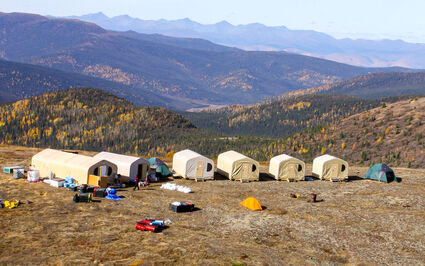Gneiss Pogo-like gold discovery at Tibbs
Soil sampling turns up drill-ready target in underexplored west North of 60 Mining News – October 30, 2020
Last updated 11/5/2020 at 6:50pm

Shane Lasley
The exploration camp at Tibbs, where Tectonic Metals has discovered high-grade gold targets reminiscent of those being mined at Pogo, which lies about 22 miles to the northwest.
Tectonic Metals Inc. Oct. 26 reported that soils sampling has identified numerous drill-ready gold exploration targets that are strikingly similar to the deposits being mine at Northern Star Resources Ltd.'s Pogo Mine about 22 miles (35 kilometers) northwest of Tibbs.
Tectonic crews collected 1,153 soil samples at Tibbs this year. This sampling primarily focused on exploring the gneissic rocks in the west of the property, where recent mapping highlights low-angle faults within moderately dipping gneissic rocks, which are key characteristics of the Pogo geological model.
"Our 2020 soil survey at Tibbs identified significant gneiss-hosted gold-in-soil anomalies in areas with low-angle faulting and shearing. These anomalies indicate mineralizing fluids traveled not only through the known high-angle structures within the intrusive rocks at Tibbs, but also through the gneissic rocks found in the western part of Tibbs," said Tectonic Metals President and CEO Tony Reda.
Five soil grids were sited over gneissic rocks found to the west of the Wolverine zone in the north and the Gray Lead zone in the south. A sixth grid was established east of the Blue Lead zone.
Tectonic reports that each soil grid returned multiple samples exceeding 100 parts per billion gold, with the best sample at 987.3 ppb gold. After going over an extensive dataset from sampling in the Goodpaster District, Tectonic has determined that 24 ppb gold is the 98th percentile threshold for gold-in-soil values in the region, suggesting any value greater than 20 ppb warrants further investigation.
The company says this year's sampling has identified multiple new anomalies entirely within gneissic host rocks, including a 2,500-meter-long gold-arsenic anomaly about 500 meters northwest of Gray Lead, where past drilling has tapped high-grade gold in steeply dipping veins.
Highlights from historical drilling at Gray Lead include 5.7 meters of 19.14 g/t gold; 5.3 meters of 15.76 g/t gold; and 4.3 meters of 6.13 g/t gold.
The Gray Lead vein shares many characteristics reminiscent of the steep North Zone vein believed to be a feeder to the shallow dipping Liese veins that have provided the bulk of the ore at Pogo Mine.
Interestingly, Gray Lead is one of the few places in the Goodpaster where high-angle veins with Pogo-style geochemical and petrological characteristics are found.
The Gray Lead vein is found within a high-angle contact zone between gneisses in the west and intrusive rocks in the east. No advanced exploration work has been conducted west of Gray Lead to test for both low- and high-angle structures within the gneissic rocks, where Pogo-style mineralization would be expected.
Tectonic says the newly defined, gneiss-hosted soil anomalies northwest of Gray Lead exhibit the gold-arsenic-bismuth-tungsten geochemistry typical of a mineralization observed in the steep vein previously drilled, which in turn closely resembles mineralization observed at Pogo.
In addition, low angle thrust faults in the gneissic rocks at Tibbs have been mapped by the United States Geological Survey and previous workers.
"Low-angle thrust faults are mapped within these gneissic rocks and are now tied to increased gold-in-soil anomalism," said Tectonic Metals President and CEO Tony Reda. "This is a powerful new observation, as gneissic rocks also host the Liese veins at Pogo, just 35 kilometers away. We again see potential for true, Pogo-style mineralization at Tibbs, and are excited to test these new targets."
In addition to this Pogo-like discovery associated with Gray Lead, a high-tenor gold-in-soil anomaly with coincident arsenic, bismuth and tungsten was discovered in a previously untested area about 1,200 meters west of the Lower Trench zone.
In mid-September, Tectonic reported initial results from this year's drilling at Lower Trench.
The best intercept at Lower Trench is 7.6 meters averaging 4.5 g/t gold, including 3.05 meters averaging 10.78 g/t gold in hole TBRB20-032.
The yet to be named anomaly west of Lower Trench is hosted by moderately dipping gneisses cut by a mapped diorite dike.
Tectonic says the discovery of new, gneiss-hosted soil anomalies represents the next evolution of the targeting methodology at Tibbs as the company investigates the prospect of Pogo-like mineralization west of the currently known exploration targets.








Reader Comments(0)